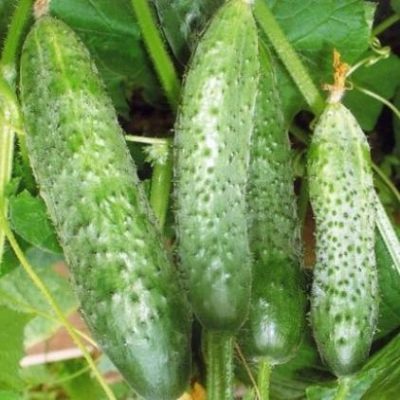
- Authors: Steinert T.V., Teplova N.S., Aliluev A.V., Avdeenko L.M., Poldnikova V.Yu., Reznik G.G.
- Year of approval: 2020
- Growth type: determinant
- Branching: weak
- Fruit weight, g: 60-70
- Fruit length, cm: 11-13
- Fruit color: dark green with short stripes
- Ripening terms: early
- Fruit shape: cylindrical
- Fruit taste: great
For summer residents who like to grow new cucumber varieties in the garden, it is recommended to try a hybrid of RMT, a domestic selection. This culture is declared as unpretentious in care, quickly adapting to climatic conditions and high-yielding.
Breeding history
An early ripe hybrid RMT was obtained as a result of the work of a group of Russian biologists: Teplovoy N.S., Steinert T.V., Alilueva A.V., Poldnikova V.Yu. and Reznik G.G in 2018. After numerous tests, in 2020 the vegetable crop was entered into the State Register of Breeding Achievements of the Russian Federation. It is recommended to grow a vegetable in different climatic zones of the country. Cucumbers can grow in a garden bed, under a temporary shelter and in a greenhouse structure.
Description of the variety
PMT is a medium-sized plant of the determinant type, characterized by a powerful central stem, weak branching, moderate foliage and a developed rhizome. A feature of the bushes is the average climbing and slow growth of lateral shoots. In a favorable environment, the height of the main stem reaches 220-250 cm.
In the flowering phase, deep yellow flowers appear on the bushes, mainly of the female type. Up to 5 fruits are tied in one leaf sinus. The plant is characterized by bundle formation of ovaries. On each bush, 20-30 zelents can ripen at the same time. This species belongs to the class of parthenocarpic, therefore, it does not need additional pollination by insects.
Characteristics of the appearance of plants and zelents
RMT cucumbers are famous for their good commercial qualities. Vegetables grow on bushes weighing 60-70, sometimes 90-100 grams and up to 13 cm long. The shape of the fruits is aligned, cylindrical. Ripe greens have a uniform dark green color, diluted with light stripes. The skin of cucumbers is thin, covered with small tubercles, small spines and pronounced pubescence of a light shade.
Ripe cucumbers can be transported over long distances, as well as stored without loss of taste and marketability for 10 days (without special storage conditions).
Purpose and taste of fruits
Zelentsy RMT will not leave anyone indifferent, because they have a great taste. The flesh of the vegetable is endowed with a dense, fleshy, crunchy structure without wateriness and voids inside. The taste of the vegetable is harmonious - sweet and refreshing, complemented by a rich aroma. It is characteristic that zelents have no bitterness, and practically no seeds are observed.
Ripe greens are eaten fresh, added to salads and assorted vegetables. In addition, cucumbers are suitable for canning and pickling.
Maturation
The RMT hybrid belongs to the category of early maturing varieties. From mass germination to ripening of the first fruits on the bushes, it takes from 37 to 44 days. Zelentsy ripens together. You can taste cucumbers in July. The crop has a long fruiting period, so you can enjoy crispy greens until mid-autumn. It is recommended to remove vegetables from bushes every 2-3 days - the more often you choose cucumbers, the more they will ripen.
Yield
The culture is declared as high-yielding, if all agrotechnical recommendations are followed. On average, 6 kg of crispy greens can be collected from 1 m2. Growing a hybrid in a greenhouse, you can get a yield even higher - up to 12-15 kg per 1 m2.
Landing scheme
In order for the plant to grow and bear fruit comfortably, it is necessary to adhere to certain planting rules, observing the density and distance between plantings. It is recommended to plant 2 cucumber bushes per 1 m2. The optimal layout for planting is 70x50 cm.
Growing and care
This hybrid is grown in a seedling way. Planting bushes is carried out in May-April, when the soil and air are well warmed up, and sharp temperature fluctuations are left behind. For planting material, strengthened bushes with a height of 15-20 cm, 2-3 leaves and a formed rhizome are used. You should not plant seedlings in the place where pumpkin crops used to grow.
The culture is unpretentious. But it needs standard care: regular watering with warm water (drip system), top dressing every 2 weeks, furrowing and weeding of the soil, garter bushes, forming into 1 stem, preventing fungi and insect infestations.
Soil requirements
There are no special requirements for the soil - the main thing is that it is light, air / moisture permeable, nutritious and non-acidic. In addition, the soil should not be swampy and heavy.

In order to collect strong, tasty and beautiful cucumbers on your site, you need to make top dressing. Lack of nutrients can negatively affect the appearance of the plant and significantly reduce the yield. Fertilize cucumbers with organic fertilizers in combination with mineral fertilizers. With the right balance of these components and adherence to the fertilizing schedule, the cucumber yield will be maximum.
Required climatic conditions
The RMT hybrid is a heat-loving plant, therefore it is recommended to grow it in a sunny area, where there is a lot of light, good air circulation, and there is protection from drafts. Cucumbers are vulnerable to temperature fluctuations and prolonged shade.
Disease and pest resistance
The immune system of the culture provides resistance to many diseases and viruses - root rot, mildew and downy mildew, as well as fusarium.

Despite their popularity, cucumbers are often attacked by diseases and pests. From them, cucumber plantings often die before the start of fruiting. In order to prevent this from happening, it is necessary to try to prevent ailments or get rid of them at the very beginning, having studied in detail their causes of occurrence, signs and methods of treatment.





























































































